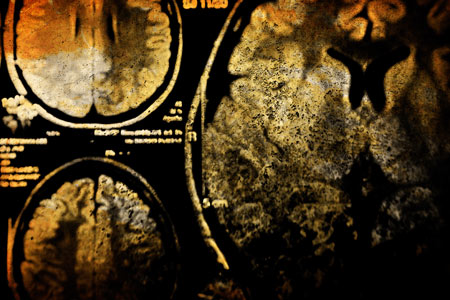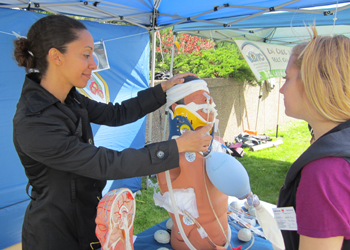Newsflash—Trauma is preventable!
Three years ago, the staff of the Montreal General Hospital (MGH) Trauma Program of the McGill University Health Centre (MUHC) decided they could no longer keep quiet.
 With 10,000 trauma
victims a year, MGH healthcare professionals were repeatedly tending to injuries
that could have easily been prevented. So they stepped up and out, and started
to pound the pavement to share their knowledge with the public: this is what is
happening in our trauma bay on a daily basis and you—our fellow citizens—have the
power of prevention.
With 10,000 trauma
victims a year, MGH healthcare professionals were repeatedly tending to injuries
that could have easily been prevented. So they stepped up and out, and started
to pound the pavement to share their knowledge with the public: this is what is
happening in our trauma bay on a daily basis and you—our fellow citizens—have the
power of prevention.
“Our Crash Course in trauma is our main educational tool for the public,” says MUHC Injury Prevention Coordinator Tara Grenier. “It’s a presentation that addresses risky behaviour. Stuff like drinking and driving, not wearing a seatbelt, not using a helmet, taking part in silly challenges such as car surfing and dares to jump from one building to another. We address these behaviours by bringing our experiences from the Trauma Centre to audiences.”
Snapshot of trauma-related injury in Canada
- Injuries are the leading cause of death for Canadians between the ages of 1 and 44, and the fourth leading cause of death for Canadians of all ages
- Many non-fatal injuries result in impairments and disabilities such as blindness, spinal cord injury and intellectual deficit due to brain injury.
- The economic burden of unintentional and intentional injuries combined is estimated to be greater than $12.7 billion per year, or 8% of the total direct and indirect costs of illness, ranking forth after cardiovascular disease, musculo-skeletal conditions and cancer.
- Another economic study estimated that unintentional injuries alone cost Canada more than $8.7 billion annually.

(Data provided by the Public Health Agency of Canada)
The Crash Course includes showing graphic images and videos of traumatic incidents. The path a trauma patient may follow is also shared. This includes the arrival to the hospital from the Trauma Bay to CT scans and X-rays, surgery, the Intensive Care Unit (ICU), and hopefully to full-recovery.
“We also bring testimonials that include people who have survived a trauma and who want to tell their stories to help prevent what happened to them from happening to others. This has a large impact,” says Grenier.
The Crash Course is taken into the community, often to secondary 5 high school students during the spring season so they can be armed with this knowledge before their graduation night, and before they go off to college. The goal is to get them to think before they make decisions that could forever change their lives for the worse.
A questionnaire is distributed to the audience following the presentations. The feedback allows Grenier and her team to understand and gauge the impact they have had and how it might be improved. Time after time, the responses have been positive and encouraging. One student wrote:
“what I learned from this presentation, and what I would share with my friends, is that I need to think my actions through and to stay prudent. It could be a two second event that could change your life forever.”
Another noted:
“Think before you act, because a trauma can take a life in many ways.”
Another observer of the Crash Course felt it was,
“very effective, instilled just the right amount of fear in me, not to make me paranoid, but definitely to make me more cautious. Thank you.”
Another educational tool used by the Injury Prevention Program is the “Think with your helmet” project.
 “We set up kiosks
in the community in collaboration with other partners to promote helmet safety,”
says Grenier. “For example, on May 17 we placed a kiosk near a Montreal bike
path. We used mannequins to show what a trauma patient who wasn’t wearing a helmet
could look like after an
accident. We also brought models of a brain so we could show what happens when
you hit your head without protection.”
“We set up kiosks
in the community in collaboration with other partners to promote helmet safety,”
says Grenier. “For example, on May 17 we placed a kiosk near a Montreal bike
path. We used mannequins to show what a trauma patient who wasn’t wearing a helmet
could look like after an
accident. We also brought models of a brain so we could show what happens when
you hit your head without protection.”
Passersby also had the opportunity to speak with members of the Association of Traumatic Brain Injury, who were present to share their experiences about what it is like to live with a traumatic brain injury. And the SPVM (Service de police de la Ville de Montréal), the SAAQ (Société de l’assurance automobile du Québec), and the AQTC (Association Québécoise des Traumatisés Crâniens) were onsite to offer tips on road safety and how to properly wear a helmet.
The question is: does this type of community education work?
Sunnybrook and Women’s College Health Sciences Centre in Toronto have a similar initiative to the Crash Course called the P.A.R.T.Y. (Prevent Alcohol and Risk-Related Trauma in Youth) Program. Their goal is to provide useful, relevant information to young people about injury (trauma) that will enable them to recognize potential injury-producing situations, make informed prevention-oriented choices, and adopt behaviours and actions that minimize risk. Recently, they conducted a study to determine if participation in such a program reduces the incidence of driving-related offences and injuries. The conclusion: a resounding yes.
Currently, these educational sessions in the community are being conducted about eight times a year. “We are looking to increase the frequency, but this requires funding,” says Grenier. “It is important work we are doing and it would be great to find a sponsor to help us with our outreach. Trauma is preventable. We just need to let more people know.”